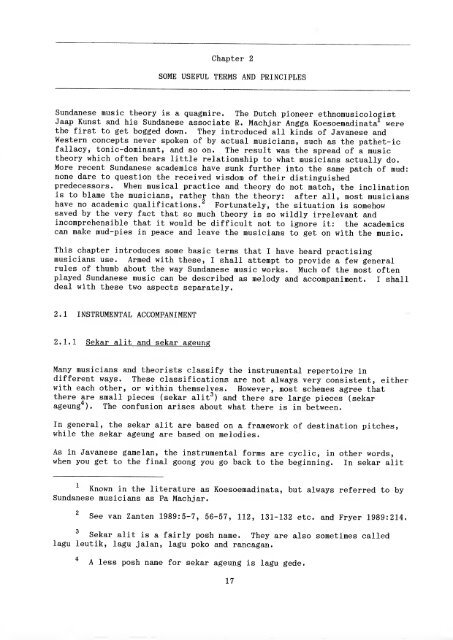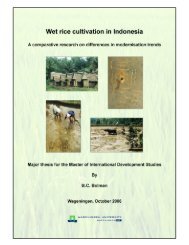Guide to Sundanese Music - Free EBooks Library
Guide to Sundanese Music - Free EBooks Library
Guide to Sundanese Music - Free EBooks Library
You also want an ePaper? Increase the reach of your titles
YUMPU automatically turns print PDFs into web optimized ePapers that Google loves.
Chapter 2<br />
SOME USEFUL TERMS AND PRINCIPLES<br />
<strong>Sundanese</strong> music theory is a quagmire. The Dutch pioneer ethnomusicologist<br />
Jaap Kunst and his <strong>Sundanese</strong> associate R. Machjar Angga Koesoemadinata were<br />
the first <strong>to</strong> get bogged down. They introduced all kinds of Javanese and<br />
Western concepts never spoken of by actual musicians, such as the pathet-ic<br />
fallacy, <strong>to</strong>nic-dominant, and so on. The result was the spread of a music<br />
theory which often bears little relationship <strong>to</strong> what musicians actually do.<br />
More recent <strong>Sundanese</strong> academics have sunk further in<strong>to</strong> the same patch of mud:<br />
none dare <strong>to</strong> question the received wisdom of their distinguished<br />
predecessors. When musical practice and theory do not match, the inclination<br />
is <strong>to</strong> blame the musicians, rather than the theory: after all, most musicians<br />
have no academic qualifications.^ Fortunately, the situation is somehow<br />
saved by the very fact that so much theory is so wildly irrelevant and<br />
incomprehensible that it would be difficult not <strong>to</strong> ignore it: the academics<br />
can make mud-pies in peace and leave the musicians <strong>to</strong> get on with the music.<br />
This chapter introduces some basic terms that I have heard practising<br />
musicians use. Armed with these, I shall attempt <strong>to</strong> provide a few general<br />
rules of thumb about the way <strong>Sundanese</strong> music works. Much of the most often<br />
played <strong>Sundanese</strong> music can be described as melody and accompaniment. I shall<br />
deal with these two aspects separately.<br />
2.1 INSTRUMENTAL ACCOMPANIMENT<br />
2'1«1 Sekar alit and sekar ageung<br />
Many musicians and theorists classify the instrumental reper<strong>to</strong>ire in<br />
different ways. These classifications are not always very consistent, either<br />
with each other, or within themselves. However, most schemes agree that<br />
there are small pieces (sekar alit^) and there are large pieces (sekar<br />
ageung ). The confusion arises about what there is in between.<br />
In general, the sekar alit are based on a framework of destination pitches,<br />
while the sekar ageung are based on melodies.<br />
As in Javanese gamelan, the instrumental forms are cyclic, in other words,<br />
when you get <strong>to</strong> the final goong you go back <strong>to</strong> the beginning. In sekar alit<br />
Known in the literature as Koesoemadinata, but always referred <strong>to</strong> by<br />
<strong>Sundanese</strong> musicians as Pa Machjar.<br />
^ See van Zanten 1989:5-7, 56-57, 112, 131-132 etc. and Fryer 1989:214.<br />
Sekar alit is a fairly posh name. They are also sometimes called<br />
lagu leutik, lagu jalan, lagu poko and rancagan.<br />
* A less posh name for sekar ageung is lagu gede.<br />
17








